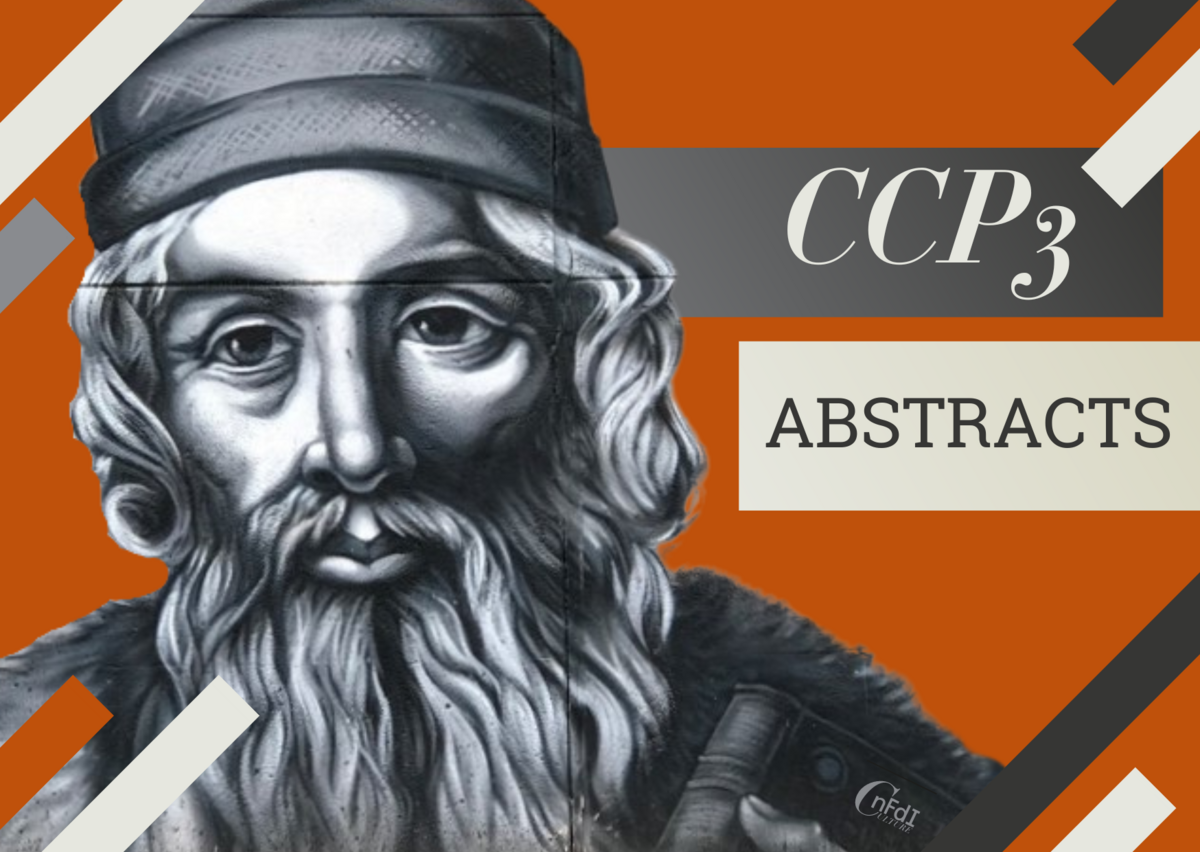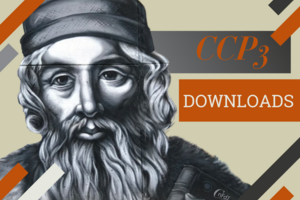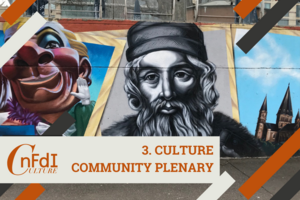Conference Proceedings | 02. March 2023
Abstracts Pecha Kucha community impulses

3rd Culture Community Plenary Abstracts
"Gutenberg graffiti at the Rhine bank in Mainz" CC-BY 4.0 Creator: Thomas Kollatz / Hans-Werner Bartz
With the invitation to the third NFDI4Culture Community Plenary, we have invited members of our community to share a vision of the digital future of your discipline with us in Pecha Kucha format. They have 6:40 minutes to present 20 slides in 20 seconds each. The speakers could develop a position on one of the following three guiding questions from the perspective of the institution or research group:
- The future has already begun: Which future-oriented methods of the present for generating and researching with data do we need to consider in NFDI4Culture?
- Building the future: NFDI4Culture in 2028. What will be necessary, where do we want to be?
- Looking back from the future: humanities and cultural studies research in 2040. How have NFDI and NFDI4Culture changed research, publishing and teaching?
Below you will find the abstracts of the submitted community impulses. Further talks are planned, information will follow.
Robert Nasarek, Germanisches Nationalmuseum Nürnberg
Title: 2028, the NFDI4Culture has managed to build an infrastructure and culture that makes it easy to create, distribute and re-use data.
Abstract: Through events, helpdesk and information material, data literacy could be increased significantly. Researchers know how to successfully digitise and enrich digital cultural assets - or can learn about it in NFDI4Culture. Tools and standards have been consolidated in such a way that it is much easier to create, connect, compare and understand data. Every research project, small or large, has possibilities for FAIR data publication and archiving, or can find all the information it needs to become a provider in its own right. This has been achieved by centralising information and training opportunities, standardising and disseminating reference models and interfaces, and highlighting or further developing appropriate tools and services - but without monopolising or politicising solutions.
Julia Rössel, DDK Photo Marburg
Title: Building(s in the) future – monuments online
Abstract: Imagine... we would like to travel within Germany in 2028 and explore the history and culture of a place. Search, map views or image recognition on the spot, information about a listed site, a building, a collection and the objects it contains - everything unfolds with just a few clicks. Through the use of artificial intelligence and machine learning, cultural heritage objects could be automatically identified, described and located through geospatial data to facilitate the indexing of new data. This initial recording would be a starting point for the competent heritage authority to check the status of the monument. It would add specialist information to the data as a result of the review. In addition, however, the data collection can also be supplemented through crowdsourcing, with citizens actively participating in correcting or adding information to further improve and expand the data collection. This would help to ensure that the heritage portal remains a dynamic and constantly evolving platform.
From a record of my favourite building with the most relevant information, I can click on to other websites, search library catalogues or web shops for media dealing with the building. I can buy tickets to visit the premises and share where I am on social media to meet friends at the site. Because I liked it so much, I can also take virtual tours of my favourite building from home. I can find out if there are any special events at this place or if I might even host a family celebration here. Here I can also research which buildings or historic places in my neighbourhood are threatened by decay and what it would take to protect them.
In this utopia, the use of data on cultural heritage in Germany would be an important building block for its preservation and promotion. The portal and the data accessible there would enable broad and open cultural mediation and help make Germany's cultural diversity and history accessible to all.
But how do we approach this utopia? We would like to address this question and, above all, motivate all those who are already working in the field to dream and become active with us.
Sol Sarratea, Participant of 3D-Hackathon Creating New Dimensions
Title: Computational approach to building the future
Abstract: Computational thinking is more than just a set of skills used by programmers; it's a problem-solving approach that can be applied in many different contexts. During this presentation, I will share some of the methods I use for tackling challenges in the realm of being a software developer. By combining it with the maieutic method, a Socratic technique that involves asking questions to uncover deeper insights, we will unlock new perspectives on the future of digital heritage.
Susanne Krömker and Steffen Bauer, Interdisciplinary Centre for Scientific Computing, Visualisation and Numerical Geometry Group
Title: "The inscribed altar slab in St. Peter, Reichenau Niederzell"
Abstract: In the church of St. Peter on the island of Reichenau, Lake Constance, is a unique altar slab with more than 300 names inscribed as inks and carvings dating from 900 to 1200 A.D. We captured this slab with our 3D scanner in March 2021 and evaluated it with scientific computing methods. Since then, the altar slab has again been inaccessible to the public under an oak cover.
The 3D data consists of a mesh of triangles on which we analyse the carvings based on the surface curvature using the GigaMesh software developed at Heidelberg University. We can make this information visible in false colours in a web interface and overlay it with the original colour images. In addition, it is possible to navigate to individual names or change the angle of incidence of the virtual light, which further improves recognisability.
Samuel Mund, Center for World Music - Foundation University of Hildesheim
Title: #aunt_nancy: a (digital) utopia
Abstract: What role will digital archives play in 2040? Although the so-called "digital revolution" began more than three decades ago, audiovisual archives in 2023 remain far behind in terms of the wealth of access and usage possibilities. Skipping over urgently needed technical refinements and necessary political processes, this talk uses a fictional platform to illustrate how a public audiovisual archive could function in 2040. Firstly, technical aspects such as deep learning, neural networks and big data / information retrieval will be discussed, secondly, the usability of the outlined digital archive offer will be looked at, and thirdly, ethical and legal implications of making large amounts of digital content available will be critically discussed.
Johannes Wolf, arthistoricum.net - Specialised Information Service Art, Photography, Design - SLUB Dresden
Title: #FreeAnnotations
Abstract: Image annotations are already a central part of the digital research process in the humanities and cultural studies. We are convinced that the importance of user-oriented annotation tools for the collection, storage and publication of meta- and research data will increase even more in the future. In our presentation, we therefore want to develop a future vision for working with image annotations and their circulation in the research cycle on the basis of a hypothetical development status of our arthistoricum.net IIIF viewer (Mirador III).
Barbara Fischer, German National Library
Title: "An Ecosystem of Linked Data - Authority Files beyond Librarian Use"
Abstract: Everything is about data in the National Research Data Infrastructure. But can you find the information you are looking for among the many zeros and ones? Humans and machines depend on semantic reference points as orientation markers. Data standards provide - equally readable for machines and humans - unambiguous search entry points, permanent identifiers and a defined set of identifying characteristics. The largest hub of reliable standards data for very different entity types in the German-speaking world, from persons to general terms, from places to works, is the Integrated Authority File (GND). We will briefly introduce it to you so that you can use it free of charge to improve your data and make your work easier.
Tilman Baumgärtel, University of Applied Studies Mainz
Title: Needs for research data for media art research using an artist's estate as a case study
The Pecha Kucha presentations will take place during the Plenary on Thursday, March 30, 2023, from 4 - 5:45 p.m.

